What is a Box-1 Defense?
A box-1 or Diamond-1 defense is a combination of 1 player guarding man-to-man and the other 4 players guarding in a box or diamond zone formation. For the contents of this article, I will be talking mostly about the box-1 but will give some rotations of the diamond-1 defense below. The basics of the two defenses are the stay but the diamond shifts the players into a diamond formation, so the rotations of the defense are different.
The box-1 defense is mostly played against teams who have one really good player and the other four are not as good. Or the defense wants to try and stop one player from scoring, so the team guards that player man to man while the other four offensive players are playing against a zone.
The box or diamond refers to the formation of the four zone players. In a box-1, the four players are in a box formation with a player on each elbow and block. In a diamond-1, the four players are in a diamond formation with one player at the top of the key, two players on the elbow or mid-post area and one player at the front of the rim.
The two different formations are really nothing more than how a coach decides which formation they like better. I, as a coach, prefer the box formation because it has better coverage around the basket. The diamond formation allows the defense to put more pressure on the ball out front but loses some of the rim coverage.
Advantages of a Box-1 or Diamond-1 Defense
1) Ability to take away offenses best player or at least trap them every time they touch the ball
This is probably the single biggest reason why most teams run a box-1. The opponent has one really good player so the defense takes two chances to stop them every possession. First, the player in man to man on defense tries to deny the offensive player the ball so as to not even allowing them to catch the ball. And second, if the offensive player does catch the ball then the defense can immediately double with one of the zone players.
As a defensive team, you are betting the other four players are not going to be able to score enough points to win if the best player is unable to score. Because of this reasoning, the defense is going to focus their attention on that one player by not letting them catch the ball and if they do then it’s an automatic double.
2) Can Cause Confusion with the Offense
The box-1 is a combination defense that most teams do not run. As an offense, the box-1 defense is not seen very often. Since it is not seen very often, most teams do not spend any practice time going against a box-1 defense. Additionally, it is a combination defense, so the offense has some choices to make.
The offense can run a zone offense but that could mean less movement making it easier to deny the best player. The offense could run a man offense, but the box zone could prevent the man offense from working. And if the offense has not prepared for a box-1 defense, the players may not understand how to attack the defense. All of these unknowns could lead the offense to be completely confused with how to attack and score against the box-1.
The box-1 could lead the offense to be confused and normally when an offense gets confused one of two things happen. First, one player just decides to get the ball and shoot because nobody is sure of what to do. Or every offensive player is looking at each other not sure what to do. This leads to the offensive players just standing around and the standing around could lead to turnovers because they make bad decisions because of the uncertainty.
3) Could have best offensive player try and do too much
Good players are good because they are competitive and driven. When a team comes out in a box-1, some players see this as a challenge. Being the competitive players they are, they then try and do too much. They want to show the defense they are up to the challenge. They start to deviate from the offense. They look for their scoring chances even more than normal.
When this happens, the best player actually becomes a problem for the offense. They start taking bad shots and turning the ball over. Now since they have not risen to the challenge the defense gave them, they start trying to do even more. And this leads to more bad shots and turnovers.
A box-1 can force an opponent to take the best player out of the game. The coaches have to calm them down and refocus their mind on the game. Sometimes this can take a minute and sometimes this can take 4 to 5 minutes. However long the offense is playing without their best player is an advantage to the defense.
Disadvantages of a Box-1 or Diamond-1 Defense
1) Usually not practiced a lot
The few times I have been a coach on a staff where we were running a box-1 defense or playing against a potential box-1 defense, the only time we practiced it was the one or two practices before that game. If we had a week of practices leading up to the game, then we would have four or five days of practice time with the box-1. That is it.
I have never been on a staff where we practiced the box-1 without knowing for a fact we would be doing it or seeing it in a game. This lack of practice time with the box-1 makes the game scenario a complete toss-up as too how the defense is going to perform.
The box-1 is a defense only to be used against a select few teams and there are some seasons where the box-1 should not or cannot be used at all. Because of the specialty of the box-1, it is never going to be a primary defense. Since it is not a primary defense, it does not get a lot of practice time.
2) Lack of rotation could lead to open shots
The box-1 defense leaves just 4 players to guard the entire half-court. If the defense is also doubling the one offensive player who is being guarded man, then this leaves a lot of floor to cover. It essentially becomes a 5 on 4 half court defense. This means the rotation of the four zone players cannot break down. If the rotations are not where they should be, then the defense will give up open looks for the offense.
If the box-1 defense is not doubling the single man and leaving the matchup to the man defender, then the defense becomes similar to a matchup zone. The defense shifts according to what the offense is doing.
Now when a team has a lack of practice with the box-1 and the four zone players are not quick and decisive with their rotations, it tends to leave open spots within the box zone. A team that runs a 2-3 matchup zone will have an easier time with the box-1 because the players can use the matchup zone principles in the box-1. If the team does not run a matchup zone, then it can be really hard for the players to learn proper rotations without practice time. And as I just stated above, most teams do not put in a lot of practice time with the box-1.
3) Rebounding
Rebounding is a key stat to any basketball game. In a box-1 defense the players are going to be rebounding without being in good defensive position. Guards must crash down to help the bigs rebound as well. Box outs are not always going to be available.
Some of the advantages I listed above can be disadvantages if the defense does not rebound. If the best offensive player is forcing shots and missing, then the defense must rebound those shots. If the offense can get rebounds from those missed shots, then the box-1 is doing its job but not being successful because of the 2nd chance opportunities the defense is giving the offense by not rebounding.
Positions of a Box-1 or Diamond-1 Defense
I have broken down all of the player positions into a box-1 setup and a diamond-1 after. This gives you the ability to look at all the rotations and as a coach make a better judgement on which setup to use. The box-1 gives better protection inside and at the rim. The diamond-1 gives better coverage outside.
I am going to only be putting the four zone defenders on the diagrams. I am assuming the man defender will be following his player over the entire half-court. So, I am removing him from the diagrams completely. If the box-1 or diamond-1 are trapping this player then the trap will be from the setup in the diagrams plus the man defender.
Box-1

This is the initial setup of the box-1. The four players are in a box formation with two at the elbows and two on the block. One of the two elbow defenders will step up and over to take the ball. The other will take the high post.
I have seen teams run a tandem setup where the two elbow defenders are stacked. The top defender picks up the ball as it crosses half-court. The bottom defender in the two man stack takes the first pass as the top defender drops to the high post on the first pass.


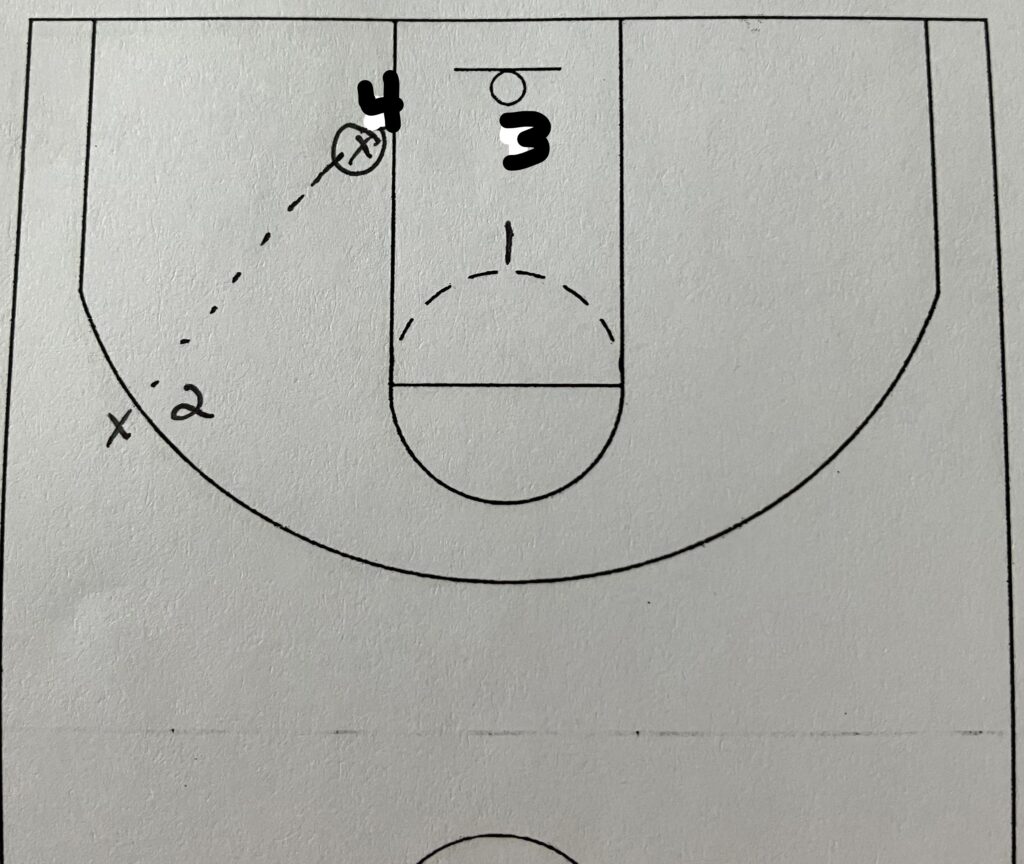
When the ball is on the wing, the ballside elbow picks up the ball while the backside elbow takes the high post. The two block defenders just slide slightly to ball side.
If the ball enters the post from the wing, then the ballside block guards the post. The backside big is at the front of the rim. The ballside elbow is splitting the difference between the passer and the post. The backside elbow is dropping into the mid-post area to possibly help on any middle post move.
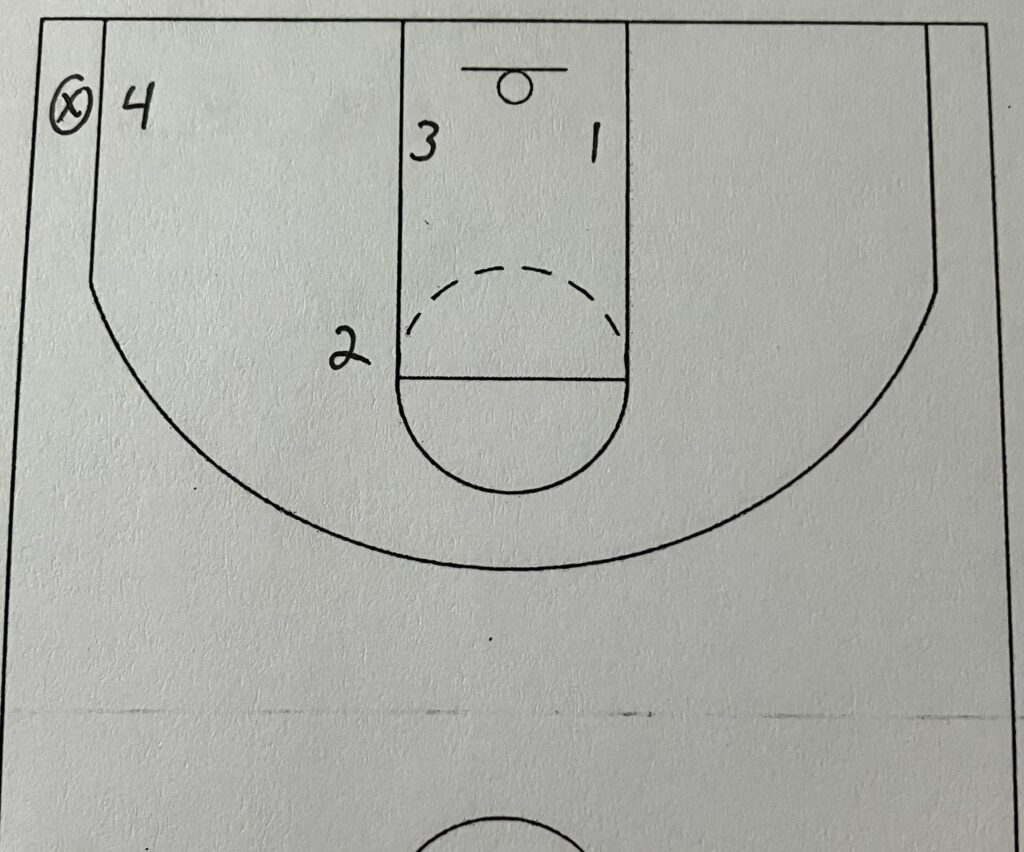
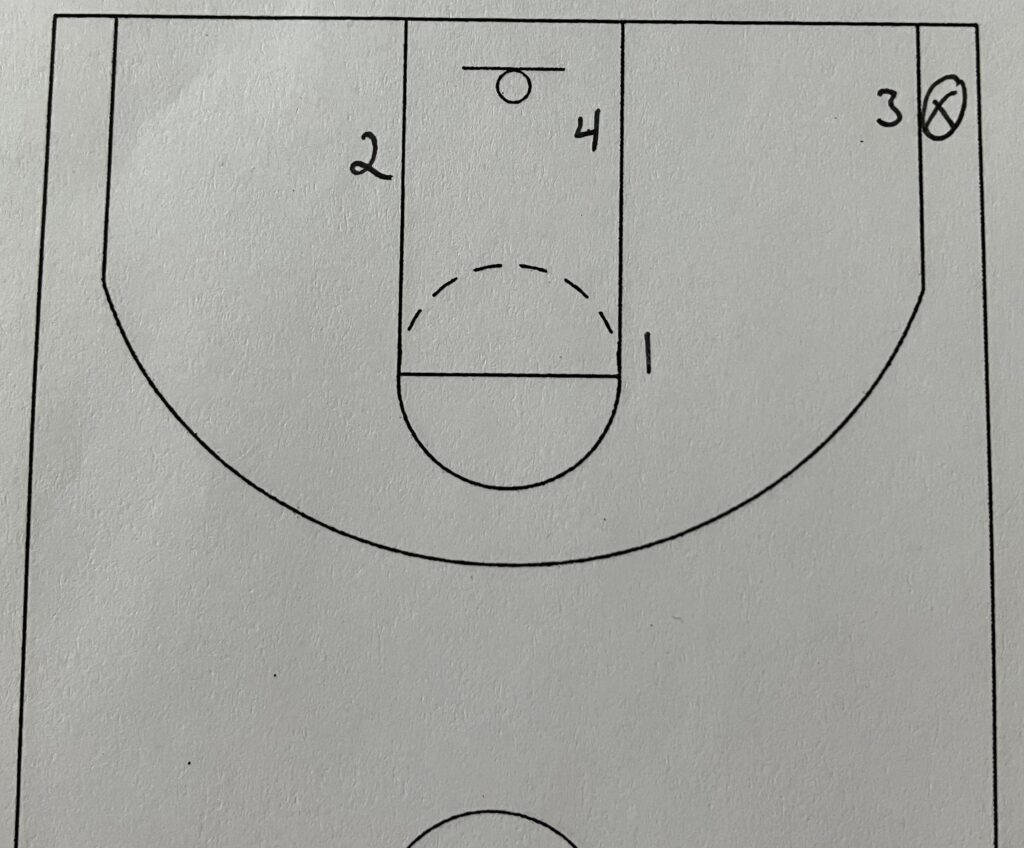
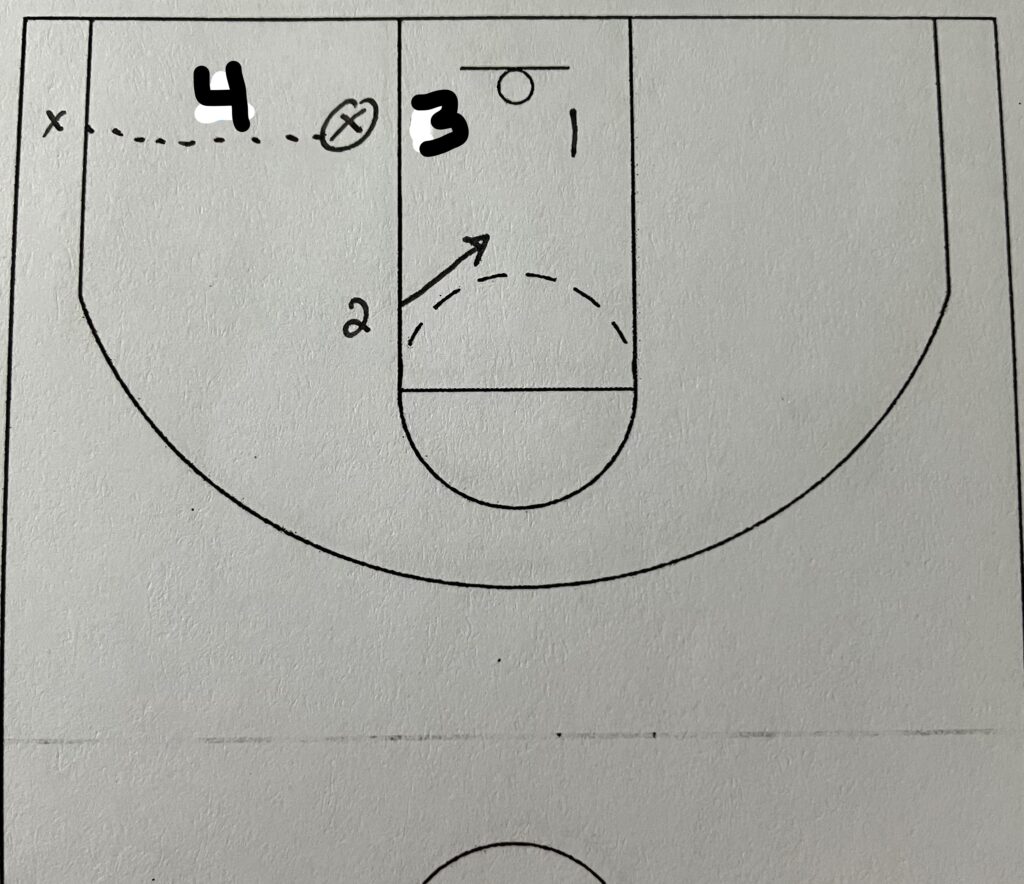
Once the ball reaches the corner, then the box must rotate to keep all the main areas of the floor covered. These are
- Ball
- Ballside Block
- Backside Block
- Ballside Elbow
Those four areas should have a defender in them. If they are vacant, then the offense can get the ball into a player’s hands in these spots and they are good scoring areas for the offense. So, as a defense, the rotations of the players should always be focused on filling these four areas.
When the ball is in the corner, the ballside big is closing out to the ball. The backside big is coming across to fill the ballside block. The backside elbow is dropping like a 1-3-1 or 1-2-2 wing to fill the backside block. The ballside elbow is filling the ballside elbow and high post areas. The key to this rotation is the backside wing dropping to the block. Any missed shot from the corner is likely to come off on the backside and the elbow defender needs to be able to get those rebounds.
If the ball enters the post from the corner, the ballside big is splitting the gap between the passer and the post. The backside block has moved over to guard the post. The backside elbow has dropped to the backside block. The ballside elbow is either coming down to double or filling the mid-post or high post. The positioning of the ballside elbow is dependent on how well the defender can guard the post 1-on-1. If the post defender needs help, then the ballside elbow can come down and double. If the post defender does not need help, then the ballside elbow can stay up higher towards the high post elbow area.
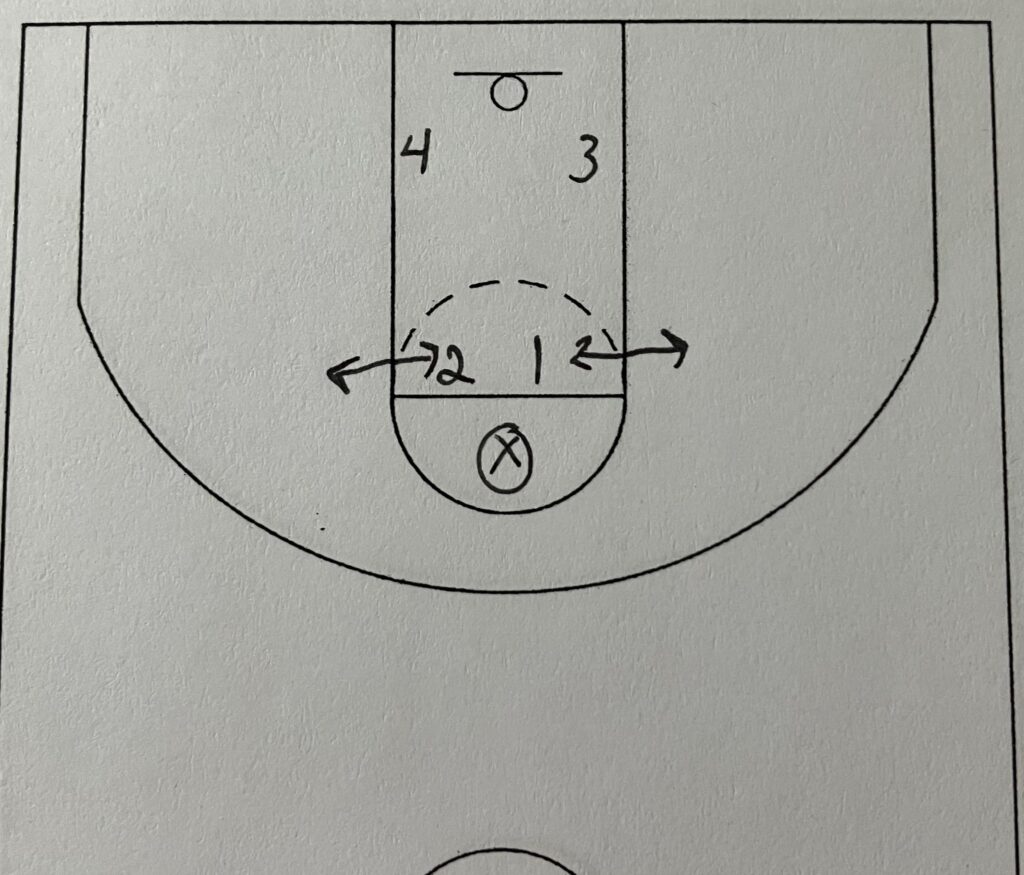

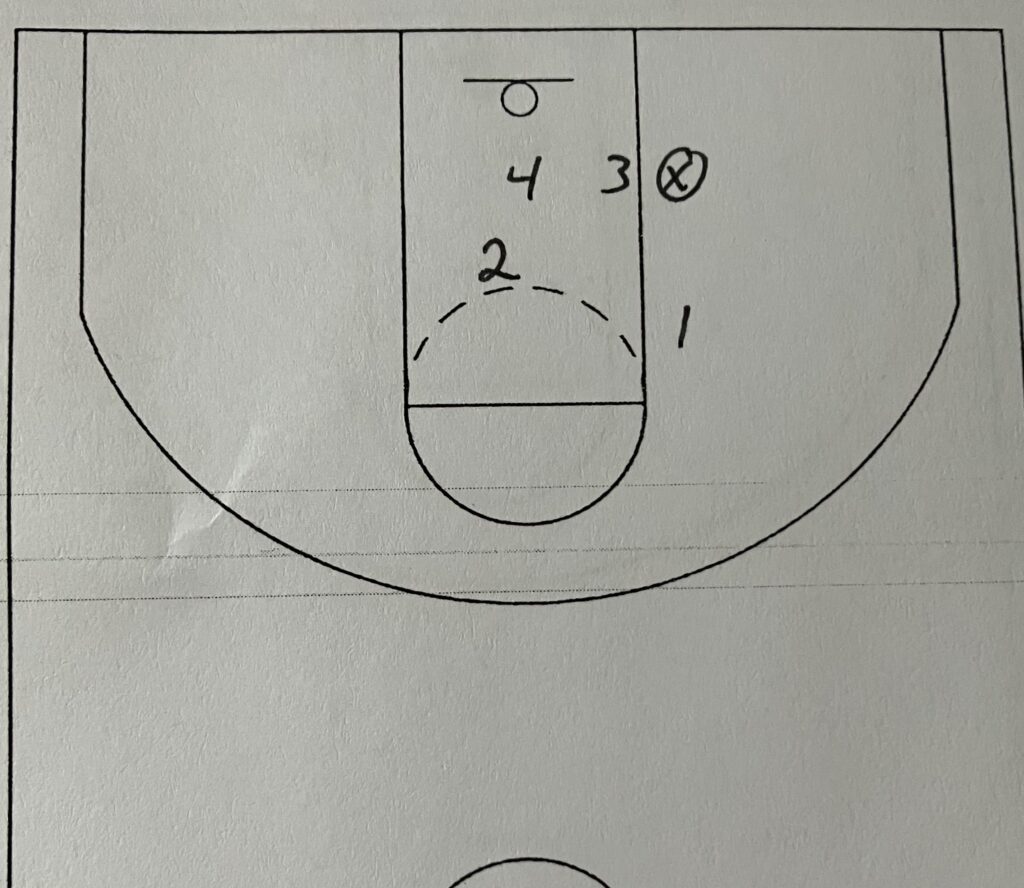
If the ball enters the high post or low post directly from the top then the rotations are minimal. At the high post, one of the elbow defenders should pick up the ball while the other is either helping or stepping towards an offensive player ready for a kick-out 3.
If the ball enters the low post straight from the top, then the rotations are easy. The ballside big guards the post. The backside big stays backside. The backside elbow drops into mid-post. The ballside elbow is stepping towards the possible kick-out 3.
Diamond-1
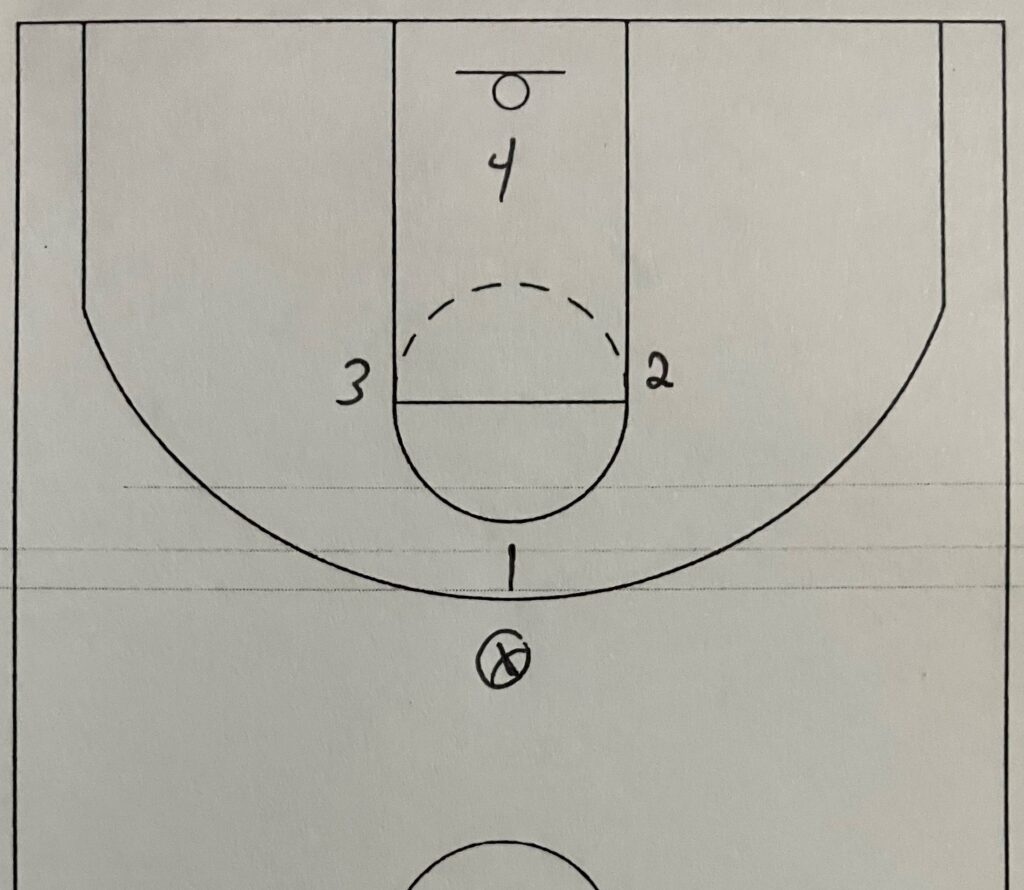
This is the diamond-1. As you can see in the picture above it is a diamond formation instead of a box setup. There is a top defender(1). Two wings(2 and 3) at the elbow. And a bottom defender(4) in front of the rim. The diamond gives better coverage on the outside to help with shooters but gives more space and room for interior offensive players.
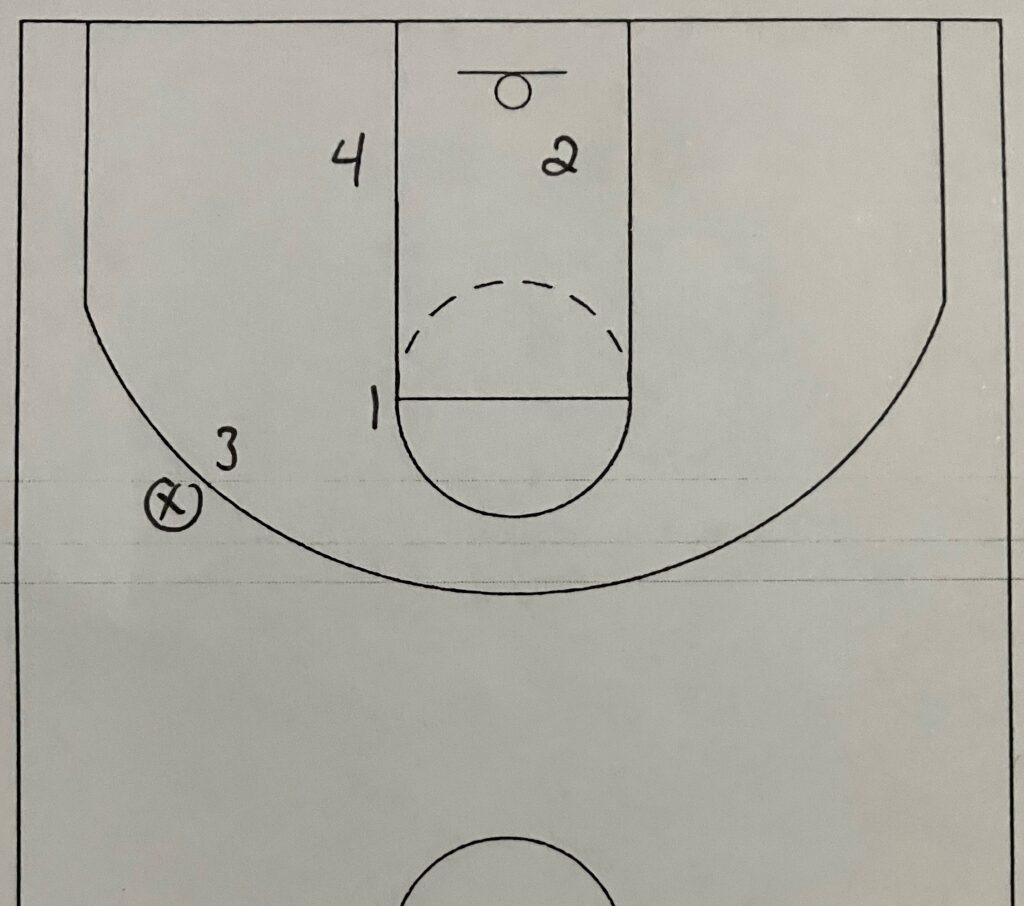

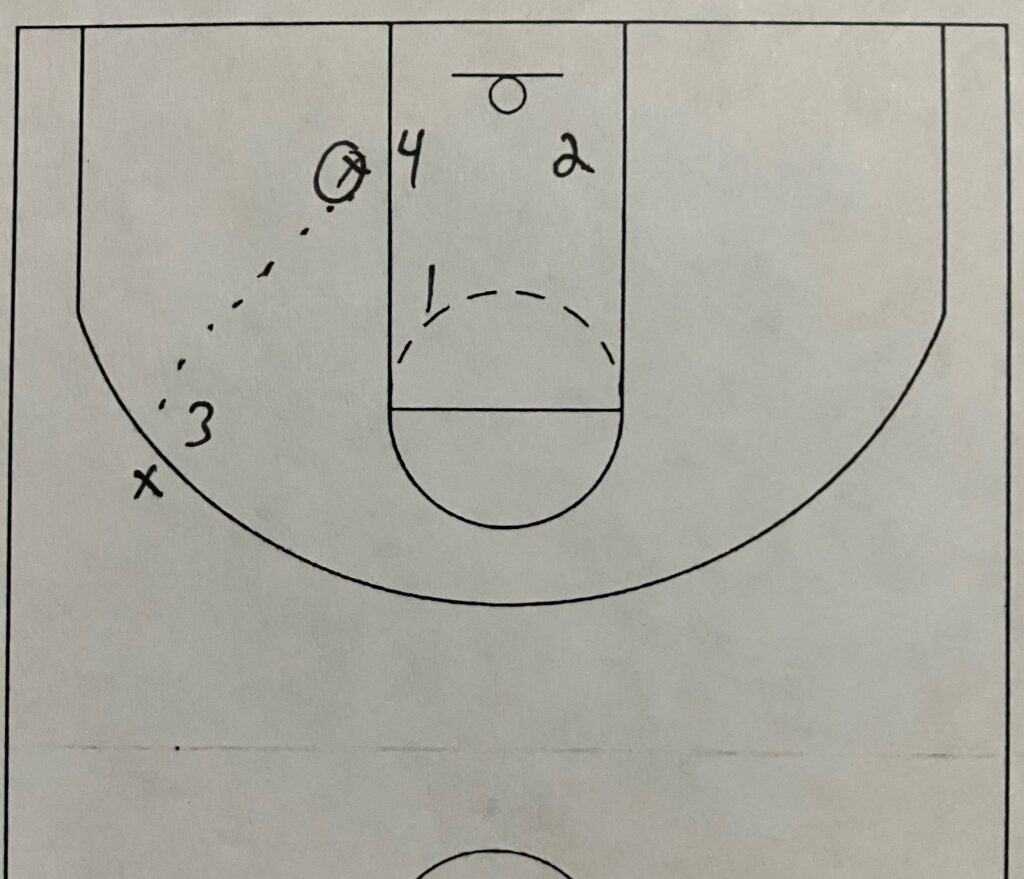
When the ball is on the wing, the ballside wing picks up the ball. The top takes the high post. The bottom takes away the ballside block. And the backside wing drops to the backside block. The four main areas I listed above are all filled with defenders. There is a lot more rotation in the diamond formation than a box formation. However, if a defense is used to running a 1-3-1 or a 1-2-2 then the rotations should not be all that different than those two zone defenses.
On the post entry from the wing, every defender is already set because the four main spots are already filled. There is no need for a lot of movement on the wing post entry.

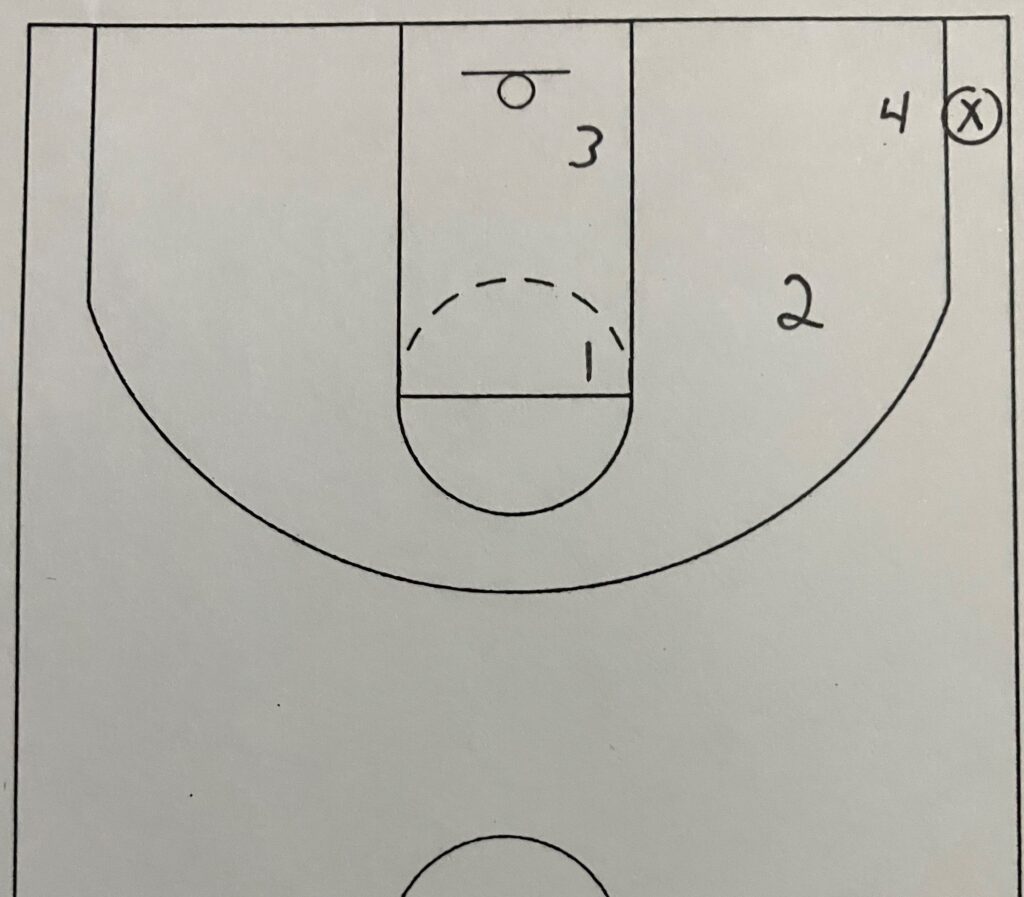
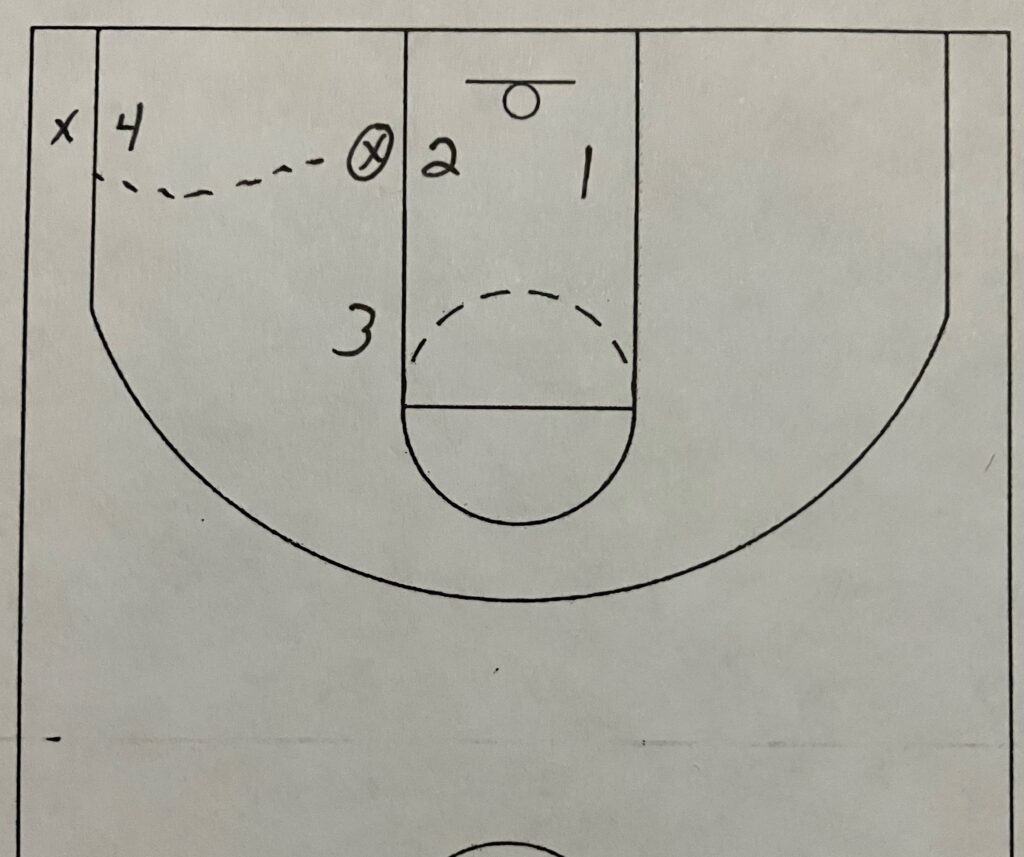
The ball being in the corner on the diamond formation can cause problems. It is either going to leave one of the main four areas of the defense open or it makes for a long rotation by a defender. The diamond is able to get out and put more pressure on the ball on the outside but it does leave space open on the inside.
In the corner, the bottom defender takes the ball. The ballside wing drops into the gap area. The top takes the high post. And the backside wing drops to the ballside block.
If the four main areas are to be covered, then the top defender must either follow the ball like a 3-2 zone or drop to the backside block. The ballside wing will be covering the high post. The ballside wing cannot cover the ballside block because a pass from the wing to the corner will leave the ballside block open until the wing can get there. By the time they get to the block a pass from the corner will be made and the offense will get an easy layup. The run for the top defender to go from the top to the block is a long run.
On a post feed from the corner the top man must drop to the block. Personally, I am only running a diamond formation if I have zero concern of the offense passing into the post. In the diamond there is a chance the 2-man which is normally the shooting guard having to guard the post. This is probably a bad scenario no matter what defense is being ran. The diamond-1 formation is a specialty formation within a specialty defense.
The diamond is a formation that might be used if the opponent plays a 5-out style with all the players standing around the 3-point line. The diamond can give better coverage with this offense.



Now if the ball is passed right from the top of the key to the post, then the defense is much better set up to defend it. At the high post, one of the wings will take the ball while the other either pinches the ball or drops to the block. The top is fading towards the closest 3-point shooter to the high post.
A pass to the block puts the bottom guarding the post. The backside wing drops like the 1-3-1 or 1-2-2. The top drops into the high post area.
Trapping in a Box-1 or Diamond-1 Defense
The box-1 defense should only trap the one offensive player that the box-1 is being used for. The rotations stay the same with trapping. The one offensive player that is being guarded man will be doubled no matter where they have the ball. The zone treats the man guarded player the same as any other player in their rotations. The trap occurs because the man-to-man defender is there as well. Aside from this no other offensive player will be trapped because the defense is not worried about them. If the defense were worried about other players, then the box-1 would not be used as a defense.
Personnel Needed for a Box-1 or Diamond-1 Defense
The box-1 defense is a counter to a good offensive player. The personnel of the defense does not matter. The best defensive player will be matched to the offensive player and the other four players are in a zone defense. So really the only personnel needed to run a box-1 is a good man-to-man defender.
Keys to a Box-1 or Diamond-1 Defense
1) Rebound
The box-1 defense is supposed to reduce the offensive’s ability to score. This is mainly against the best player. To help achieve this there cannot be 2nd chance points. If the offense is able to get offensive rebounds, then the defense is not effective. The four defensive zone players must collapse on each shot and get rebounds. If the defense can force the other four offensive players into shooting, then the hope is those four players are not good offensive players and will miss shots. The defense needs to make sure those missed shots are the only shots the offense gets each possession.
2) Communicate
The box-1 defense only works with great communication. There are two different talking points that need to be going on at the same time in the box-1 defense.
The first communication that the defense needs to be constantly is where the offensive player being guarded man is and where they are going. The defender guarding man needs to know if any screens are coming and where the ball is located at. If the man defender is face guarding, then they will probably not have sight of the ball. Without watching the floor and focusing on just denying their man they need help with where the ball is at. So, the other four defenders have to be talking to give the help to the man defender.
The second type of communication is between the four zone players. They need to be talking about where the ball is at. Who is taking the ball. And how the other three players are rotating behind the ball. If the team plays more of a matchup box zone, then these four players should be passing offensive players back and forth. Without communication this defense becomes very hard to execute.
3) Keep Best Offensive Player In Check
The entire reason to go to a box-1 defense is to limit the ability of the offense’s best player. If the box-1 is not reducing the scoring by the offensive best player, then there is no reason to use it. The box-1 tries to get the other four offensive players to make plays and score points to beat the defense. The box-1 wants to keep the best offensive player from scoring their average point total. The thought is if the best player does not score as much as normal then the other four offensive players will not score enough to win the game. Whether the defense is going to trap the best player or not, the best offensive player should be kept under their season scoring average when using the box-1 defense.
Youth Basketball
I cannot recommend using a box-1 defense at the youth level. It is such a specialty defense that it does not make any sense to use at the youth level for any good development. It is a wild card defense in my opinion to be used in very limited situations. I see it mainly used in varsity high school only a couple of times a year among all the games I coach or scout or watch. Tournament games with a major discrepancy in skill between teams seem to be the biggest places where a combination defense like the box-1 are used most often. Later in the tournament where all the teams are good, combination defenses go away.
Conclusion
The box-1 defense is a combination defense of man and zone. It should be used rarely if at all. It can be effective. But its effectiveness is usually more because of the offense struggling with it than the defense playing really well. It is not something that gets a lot of practice time, so teams have an unfamiliarity with it. This unfamiliarity is both for the offense and defense. Personally, if I want to use a box-1 defense, I use my man-to-man defense but make every defender off the ball have a foot in the lane except for the best offensive player’s defender. This simple adjustment keeps the principals and knowledge of the man defense for the players. This is my own personal workaround. This keeps the team from having to spend any time on trying to learn the box-1 defense.

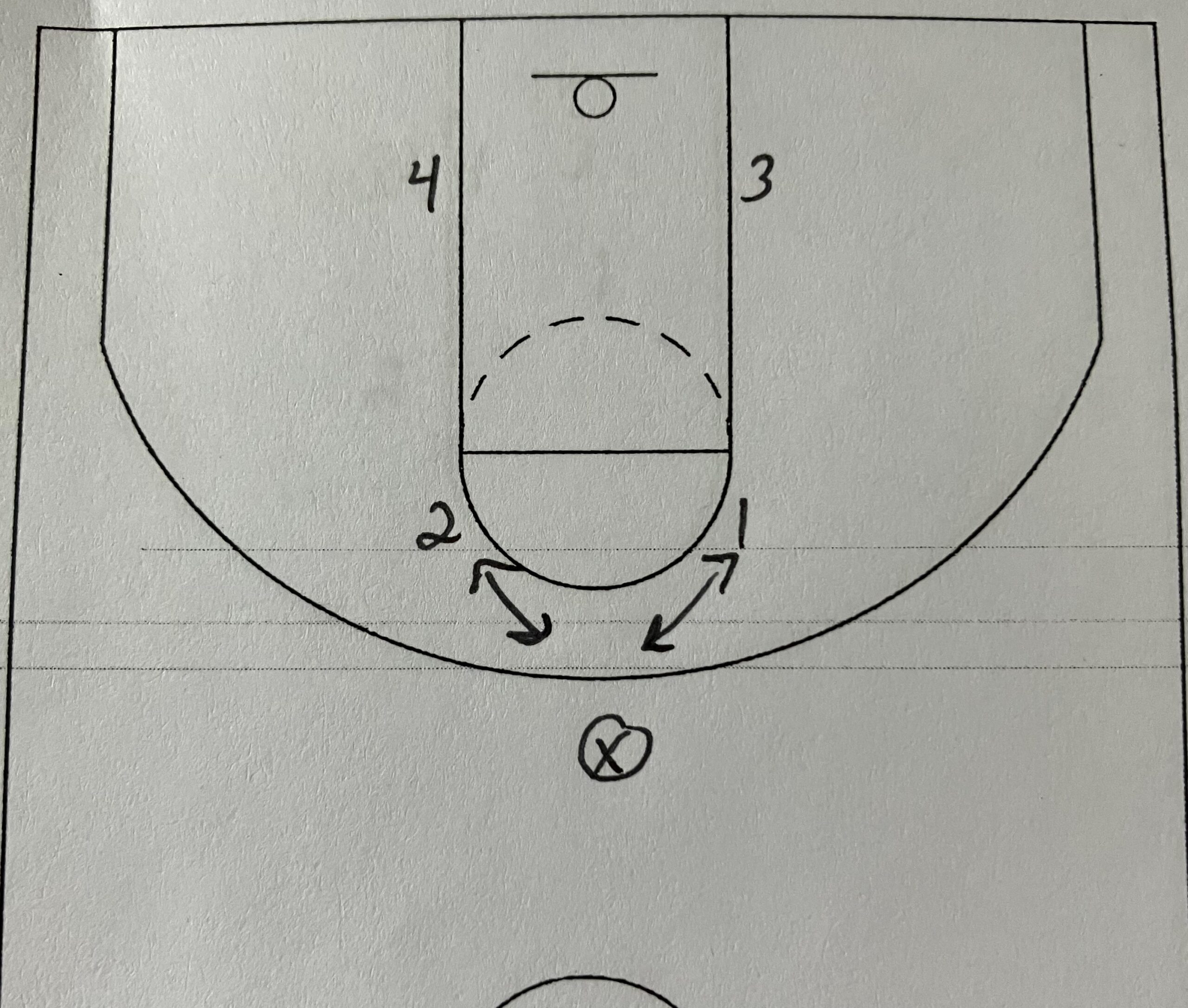
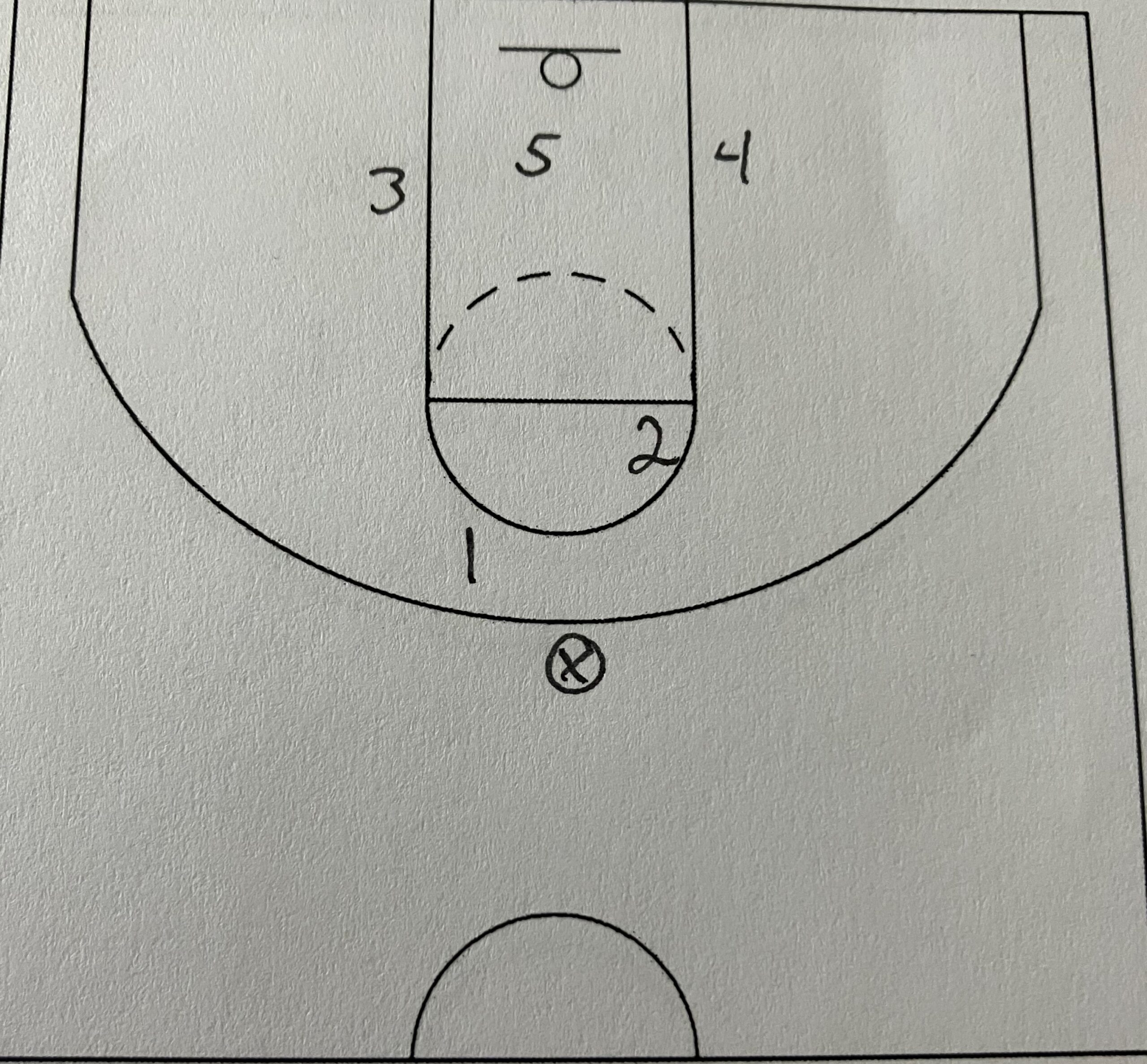

2 thoughts on “Box-1 or Diamond-1 Defense Guide”